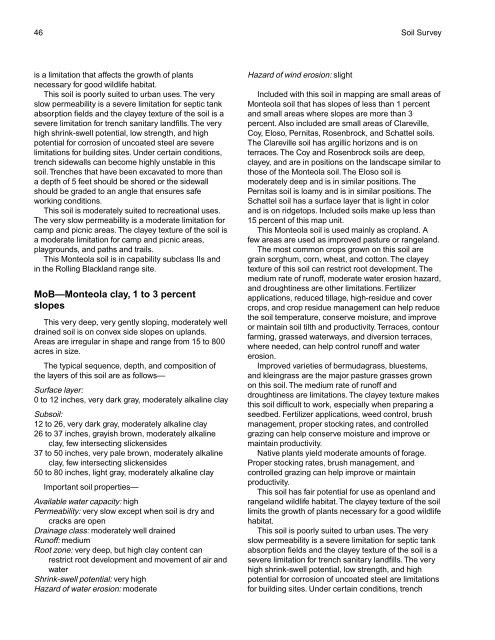Soil Survey of Karnes County, Texas - Soil Data Mart - US ...
Soil Survey of Karnes County, Texas - Soil Data Mart - US ...
Soil Survey of Karnes County, Texas - Soil Data Mart - US ...
Create successful ePaper yourself
Turn your PDF publications into a flip-book with our unique Google optimized e-Paper software.
46 <strong>Soil</strong> <strong>Survey</strong><br />
is a limitation that affects the growth <strong>of</strong> plants<br />
necessary for good wildlife habitat.<br />
This soil is poorly suited to urban uses. The very<br />
slow permeability is a severe limitation for septic tank<br />
absorption fields and the clayey texture <strong>of</strong> the soil is a<br />
severe limitation for trench sanitary landfills. The very<br />
high shrink-swell potential, low strength, and high<br />
potential for corrosion <strong>of</strong> uncoated steel are severe<br />
limitations for building sites. Under certain conditions,<br />
trench sidewalls can become highly unstable in this<br />
soil. Trenches that have been excavated to more than<br />
a depth <strong>of</strong> 5 feet should be shored or the sidewall<br />
should be graded to an angle that ensures safe<br />
working conditions.<br />
This soil is moderately suited to recreational uses.<br />
The very slow permeability is a moderate limitation for<br />
camp and picnic areas. The clayey texture <strong>of</strong> the soil is<br />
a moderate limitation for camp and picnic areas,<br />
playgrounds, and paths and trails.<br />
This Monteola soil is in capability subclass IIs and<br />
in the Rolling Blackland range site.<br />
MoB—Monteola clay, 1 to 3 percent<br />
slopes<br />
This very deep, very gently sloping, moderately well<br />
drained soil is on convex side slopes on uplands.<br />
Areas are irregular in shape and range from 15 to 800<br />
acres in size.<br />
The typical sequence, depth, and composition <strong>of</strong><br />
the layers <strong>of</strong> this soil are as follows—<br />
Surface layer:<br />
0 to 12 inches, very dark gray, moderately alkaline clay<br />
Subsoil:<br />
12 to 26, very dark gray, moderately alkaline clay<br />
26 to 37 inches, grayish brown, moderately alkaline<br />
clay, few intersecting slickensides<br />
37 to 50 inches, very pale brown, moderately alkaline<br />
clay, few intersecting slickensides<br />
50 to 80 inches, light gray, moderately alkaline clay<br />
Important soil properties—<br />
Available water capacity: high<br />
Permeability: very slow except when soil is dry and<br />
cracks are open<br />
Drainage class: moderately well drained<br />
Run<strong>of</strong>f: medium<br />
Root zone: very deep, but high clay content can<br />
restrict root development and movement <strong>of</strong> air and<br />
water<br />
Shrink-swell potential: very high<br />
Hazard <strong>of</strong> water erosion: moderate<br />
Hazard <strong>of</strong> wind erosion: slight<br />
Included with this soil in mapping are small areas <strong>of</strong><br />
Monteola soil that has slopes <strong>of</strong> less than 1 percent<br />
and small areas where slopes are more than 3<br />
percent. Also included are small areas <strong>of</strong> Clareville,<br />
Coy, Eloso, Pernitas, Rosenbrock, and Schattel soils.<br />
The Clareville soil has argillic horizons and is on<br />
terraces. The Coy and Rosenbrock soils are deep,<br />
clayey, and are in positions on the landscape similar to<br />
those <strong>of</strong> the Monteola soil. The Eloso soil is<br />
moderately deep and is in similar positions. The<br />
Pernitas soil is loamy and is in similar positions. The<br />
Schattel soil has a surface layer that is light in color<br />
and is on ridgetops. Included soils make up less than<br />
15 percent <strong>of</strong> this map unit.<br />
This Monteola soil is used mainly as cropland. A<br />
few areas are used as improved pasture or rangeland.<br />
The most common crops grown on this soil are<br />
grain sorghum, corn, wheat, and cotton. The clayey<br />
texture <strong>of</strong> this soil can restrict root development. The<br />
medium rate <strong>of</strong> run<strong>of</strong>f, moderate water erosion hazard,<br />
and droughtiness are other limitations. Fertilizer<br />
applications, reduced tillage, high-residue and cover<br />
crops, and crop residue management can help reduce<br />
the soil temperature, conserve moisture, and improve<br />
or maintain soil tilth and productivity. Terraces, contour<br />
farming, grassed waterways, and diversion terraces,<br />
where needed, can help control run<strong>of</strong>f and water<br />
erosion.<br />
Improved varieties <strong>of</strong> bermudagrass, bluestems,<br />
and kleingrass are the major pasture grasses grown<br />
on this soil. The medium rate <strong>of</strong> run<strong>of</strong>f and<br />
droughtiness are limitations. The clayey texture makes<br />
this soil difficult to work, especially when preparing a<br />
seedbed. Fertilizer applications, weed control, brush<br />
management, proper stocking rates, and controlled<br />
grazing can help conserve moisture and improve or<br />
maintain productivity.<br />
Native plants yield moderate amounts <strong>of</strong> forage.<br />
Proper stocking rates, brush management, and<br />
controlled grazing can help improve or maintain<br />
productivity.<br />
This soil has fair potential for use as openland and<br />
rangeland wildlife habitat. The clayey texture <strong>of</strong> the soil<br />
limits the growth <strong>of</strong> plants necessary for a good wildlife<br />
habitat.<br />
This soil is poorly suited to urban uses. The very<br />
slow permeability is a severe limitation for septic tank<br />
absorption fields and the clayey texture <strong>of</strong> the soil is a<br />
severe limitation for trench sanitary landfills. The very<br />
high shrink-swell potential, low strength, and high<br />
potential for corrosion <strong>of</strong> uncoated steel are limitations<br />
for building sites. Under certain conditions, trench
















